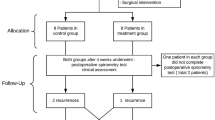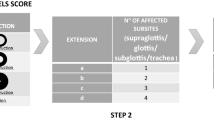Abstract
Purpose
This study aimed to assess the changes in spirometry parameters or indices after relieving laryngotracheal stenosis (LTS) in adult patients.
Methods
A systematic review and meta-analysis of studies from PubMed, Scopus, Web of Science, Cochrane Library, and EBSCO databases was conducted for assessing changes in spirometry values after endoscopic balloon dilatation of LTS in adults. The Preferred Reporting Items for Systematic Reviews and Meta-Analyses (PRISMA) guidelines were followed. Relevant data, such as changes in mean spirometry values between preoperative and postoperative interventions, and findings of receiver operating characteristic curve analyses for predicting the need for surgical intervention, were extracted.
Results
Ten studies including 330 patients overall met the inclusion criteria. Significant improvements were observed from preoperative to postoperative mean values of different spirometry parameters and indices. The overall mean differences in peak expiratory flow (ΔPEF), expiratory disproportion index (ΔEDI), and peak inspiratory flow (ΔPIF) were 2.26 L/s (95% CI 2.14–2.38), 27.94 s (95% CI 26.36–29.52), and 1.21 L/s (95% CI 0.95–1.47), respectively. ΔPEF and ΔPIF values increased, while ΔEDI decreased. In predicting the need for surgical intervention, EDI had the highest sensitivity (88%), and forced expiratory volume per second/forced vital capacity had the highest specificity (85%).
Conclusion
Spirometry is a valuable tool for assessing patients with LTS. PEF, EDI, and PIF were the most commonly reported spirometry parameters that significantly improved after airway stenosis was relieved.




Similar content being viewed by others
Data availability
Not applicable.
References
Carpenter DJ, Ferrante S, Bakos SR, Clary MS, Gelbard AH, Daniero JJ (2019) Utility of routine spirometry measures for surveillance of idiopathic subglottic stenosis. JAMA Otolaryngol Head Neck Surg 145:21–26. https://doi.org/10.1001/jamaoto.2018.2717
Crosby T, McWhorter A, McDaniel L, Kunduk M, Adkins L (2021) Predicting need for surgery in recurrent laryngotracheal stenosis using changes in spirometry. Laryngoscope 131:2199–2203. https://doi.org/10.1002/lary.29239
Nouraei SA, Nouraei SM, Patel A et al (2013) Diagnosis of laryngotracheal stenosis from routine pulmonary physiology using the expiratory disproportion index. Laryngoscope 123:3099–3104. https://doi.org/10.1002/lary.24192
Maldonado F, Loiselle A, Depew ZS et al (2014) Idiopathic subglottic stenosis: an evolving therapeutic algorithm. Laryngoscope 124:498–503. https://doi.org/10.1002/lary.24287
Alrabiah A, Almohanna S, Aljasser A et al (2022) Utility of spirometry values for evaluating tracheal stenosis patients before and after balloon dilation. Ear Nose Throat J 101:62–67. https://doi.org/10.1177/0145561320936968
Rosow DE, Barbarite E (2016) Review of adult laryngotracheal stenosis: pathogenesis, management, and outcomes. Curr Opin Otolaryngol Head Neck Surg 24:489–493. https://doi.org/10.1097/MOO.0000000000000305
Smith MM, Cotton RT (2018) Diagnosis and manage ment of laryngotracheal stenosis. Expert Rev Respir Med 12:709–717. https://doi.org/10.1080/17476348.2018.1495564
Tie K, Buckmire RA, Shah RN (2020) The role of Spirometry and Dyspnea Index in the management of subglottic stenosis. Laryngoscope 130:2760–2766. https://doi.org/10.1002/lary.28337
Monnier P, Dikkers FG, Eckel H et al (2015) Preoperative assessment and classification of benign laryngotracheal stenosis: a consensus paper of the European Laryngological Society. Eur Arch Otorhinolaryngol 272:2885–2896. https://doi.org/10.1007/s00405-015-3635-4
Curley FJ (1997) Dyspnea. In: Irwin RS, Curley FJ, Grossman RF (eds) Diagnosis and treatment of symptoms of the respiratory tract. Futura Publishing Company Inc, Armonk, pp 55–111
Empey DW (1972) Assessment of upper airways obstruction. Br Med J 3:503–505. https://doi.org/10.1136/bmj.3.5825.503
Miller RD, Hyatt RE (1973) Evaluation of obstructing lesions of the trachea and larynx by flow-volume loops. Am Rev Respir Dis 108:475–481
Abdullah A, Alrabiah A, Habib SS et al (2019) The value of spirometry in subglottic stenosis. Ear Nose Throat J 98:98–101. https://doi.org/10.1177/0145561318823309
Ntouniadakis E, Sundh J, von Beckerath M (2022) Monitoring adult subglottic stenosis with Spirometry and Dyspnea Index: a novel approach. Otolaryngol Head Neck Surg 167:517–523. https://doi.org/10.1177/01945998211060817
Moher D, Liberati A, Tetzlaff J, Altman DG (2009) Preferred reporting items for systematic reviews and meta-analyses: the PRISMA statement. PLoS Med 6:e1000097. https://doi.org/10.1371/journal.pmed.1000097
National Heart Lung and Blood Institute (2021) Study quality assessment tools. https://www.nhlbi.nih.gov/health-topics/study-quality-assessment-tools. Accessed 1 November 2022.
Higgins JP, Altman DG, Gøtzsche PC et al (2011) The Cochrane Collaboration’s tool for assessing risk of bias in randomised trials. BMJ 343:5928. https://doi.org/10.1136/bmj.d5928
Kraft SM, Sykes K, Palmer A, Schindler J (2015) Using pulmonary function data to assess outcomes in the endoscopic management of subglottic stenosis. Ann Otol Rhinol Laryngol 124:137–142. https://doi.org/10.1177/0003489414548915
Park M, Tie K, Davis H, Hall J, Buckmire RA, Shah RN (2023) Can the remote use of a peak flow meter predict severity of subglottic stenosis and surgical timing? Laryngoscope 133:628–633. https://doi.org/10.1002/lary.30257
Alrabiah A, Alsayed A, Aljasser A et al (2021) Effect of inhaled fluticasone propionate on laryngotracheal stenosis after balloon dilation: a randomized controlled trial. Eur Arch Otorhinolaryngol 278:1505–1513. https://doi.org/10.1007/s00405-021-06622-x
Yung KC, Chang J, Courey MS (2020) A randomized controlled trial of adjuvant mitomycin-c in endoscopic surgery for laryngotracheal stenosis. Laryngoscope 130:706–711. https://doi.org/10.1002/lary.28025
Sanchez-Guerrero J, Guerlain J, Samaha S, Burgess A, Lacau St Guily J, Périé S (2018) Upper airway obstruction assessment: peak inspiratory flow and clinical COPD Questionnaire. Clin Otolaryngol 43:1303–1311. https://doi.org/10.1111/coa.13149
Acknowledgements
The authors wish to convey special thanks to Editage (www.editage.com) for the English language editing of this manuscript.
Funding
The author(s) received no financial support for the research, authorship, and/or publication of this article.
Author information
Authors and Affiliations
Corresponding author
Ethics declarations
Conflict of interests
The authors declared no potential conflicts of interest with respect to the research, authorship, and/or publication of this article.
Additional information
Publisher's Note
Springer Nature remains neutral with regard to jurisdictional claims in published maps and institutional affiliations.
Rights and permissions
Springer Nature or its licensor (e.g. a society or other partner) holds exclusive rights to this article under a publishing agreement with the author(s) or other rightsholder(s); author self-archiving of the accepted manuscript version of this article is solely governed by the terms of such publishing agreement and applicable law.
About this article
Cite this article
Alshareef, W., Almutairi, N., Sindi, A. et al. Spirometry in laryngotracheal stenosis: a systematic review and meta-analysis. Eur Arch Otorhinolaryngol 280, 4783–4792 (2023). https://doi.org/10.1007/s00405-023-08159-7
Received:
Accepted:
Published:
Issue Date:
DOI: https://doi.org/10.1007/s00405-023-08159-7




